If you love nature and have a desire to enhance your outdoor space, then creating a beautiful tulip garden is the perfect way to do that!
Nothing compares to being surrounded by vibrant colours and incredible scents as waves of multicolored tulips bloom throughout your yard.
Not only do tulips add life and beauty to any outdoor area, but they are also low maintenance – so no matter how much or little gardening experience you have, you’re sure to be successful in growing these stunning flowers.
Read on for some helpful tips and ideas for creating a gorgeous tulip garden that will bring joy all season long!
Types of Tulips
Species Tulips
The first thing to consider when planning your garden is the type of tulips you’d like to grow.
There are many varieties that offer different colors and shapes, so it’s important to understand the different types before getting started.
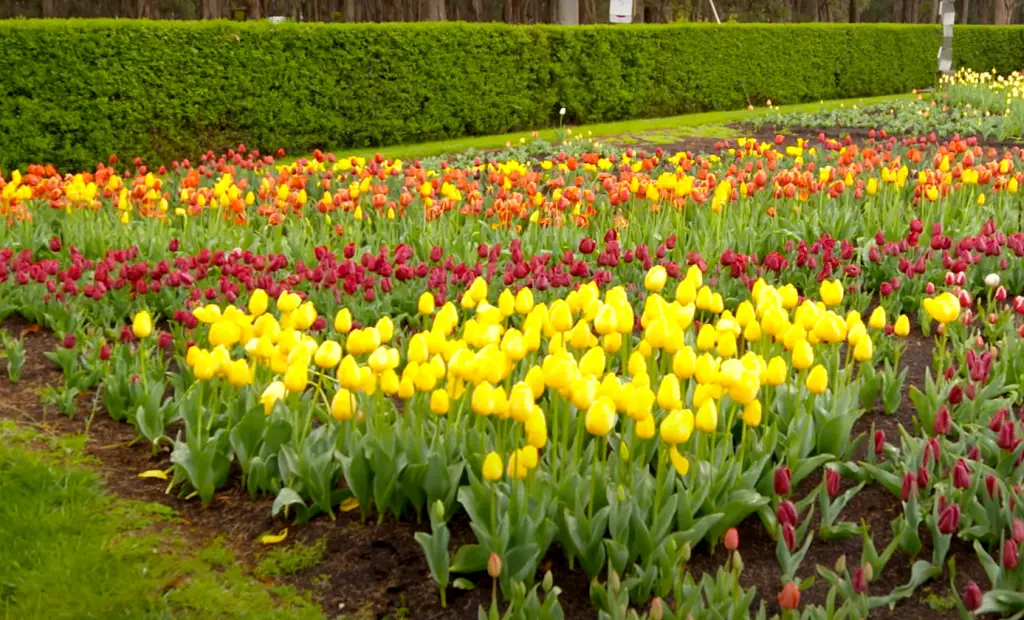
Species tulips are among the most popular, as they can be easily adapted for any garden or landscape.
These tulips, often referred to as botanical tulips, are the most varied and come in a wide range of colors. They also have fragrances ranging from sweet to spicy.
Parrot Tulips
These feature distinctive frilled petals and come in a variety of vibrant colors, including red, yellow, pink, white, and orange. They are also known for their unique shape – the edges of each petal have a slightly curled appearance which gives them an exotic look.
Fringed Tulips
Fringed tulips are also quite popular and are easily recognized by the fringed edges of their petals.
These tulips come in a wide variety of colors, such as white, pink, yellow, and red. They look great when planted in large clusters or even when used as an accent in a garden bed.
Rembrandt Tulips
These tulips have an incredibly unique look, featuring multicolored petals with striking streaks or brushstrokes of colour.
They are quite exotic in appearance and come in a range of colors, such as yellow, orange, rose, white and purple. Rembrandt tulips are best planted in clusters for the most impact.
Darwin Hybrid Tulips
Darwin hybrid is quickly becoming one of the most popular varieties. These tulips come in a stunning array of colors and are known for their long-lasting blooms. They look great when planted in mass or scattered throughout a garden bed.
Triumph Tulips
These tulips are known for their large, fragrant blooms and come in a variety of colors including pink, yellow, white and red. They also have a long-lasting bloom time which makes them ideal for brightening up any garden space.
Lily-Flowered Tulips
These tulips are easily recognizable for their lily-like petals which curl inward as the blossom matures. They come in a range of colors, such as pink, red and yellow.
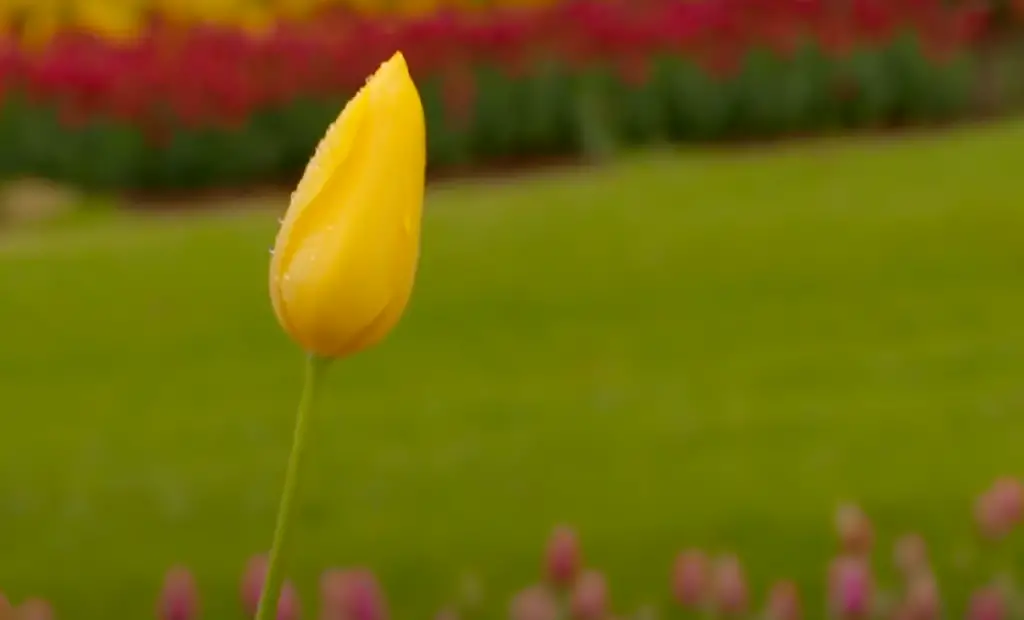
This variety is incredibly striking when planted with other types of tulips or used as an accent flower in a garden bed.
Single Early Tulips
These tulips are known for their early blooming season and are one of the hardiest varieties. They come in a wide range of colors, from white to yellow, red and pink.
Single early tulips look best when planted in groups as they have an incredibly beautiful effect with large clusters of color.
Double Early Tulips
These tulips feature two layers of petals and come in a range of colors, such as yellow, pink and red. They are perfect for planting in clusters or grouped together with other types of tulips to create an even more stunning effect.
Single Late Tulips
Single late tulips feature a single layer of large petals and come in a range of colors from white to yellow, pink and red. They are perfect for adding a vibrant color to any garden or landscape.
Double Late Tulips
Double late tulips have an incredibly beautiful and unique look, featuring two layers of large petals that open to form a cup shape. These tulips come in a range of colors, including yellow, white and pink. They are best planted in groups for the most vibrant effect.
Viridiflora Tulips
These tulips feature a unique look, with speckled petals and yellow-green streaks. They come in a range of colors, such as white, pink and red and are best for adding an exotic touch to any garden or landscape.
Kaufmanniana Tulips
Kaufmanniana tulips are also known as water lily tulips due to their distinctive shape. These tulips come in a variety of colors, from white to yellow and pink.
They look best when planted in clusters or grouped together with other types of tulips for an even more stunning effect.
Fosteriana Tulips
Fosteriana tulips feature large, star-shaped petals and come in a range of colors, such as white, yellow, pink and red. They are best planted in clusters for the most impactful effect.
Greigii Tulips
These tulips are known for their unique shape and come in a range of colors, from white to yellow, pink and red. They look great when planted in groups or grouped together with other types of tulips to create a stunning display.
Planting Tulips
When it comes to planting tulips, there are a few things to keep in mind. First, make sure that you are planting them in well-drained soil and in an area with adequate sunlight. It is also important to plant them at the correct depth—generally about 8 inches deep.
When it comes to fertilising, tulips prefer a soil that is rich in nitrogen and phosphorus.Finally, remember to water your tulips regularly to ensure they get enough moisture. With these tips in mind, you can enjoy beautiful blooms throughout the spring season!
Tulip Care
Tulips require very little maintenance in order to thrive. They should be watered regularly, especially during dry periods or when the temperatures are particularly high.
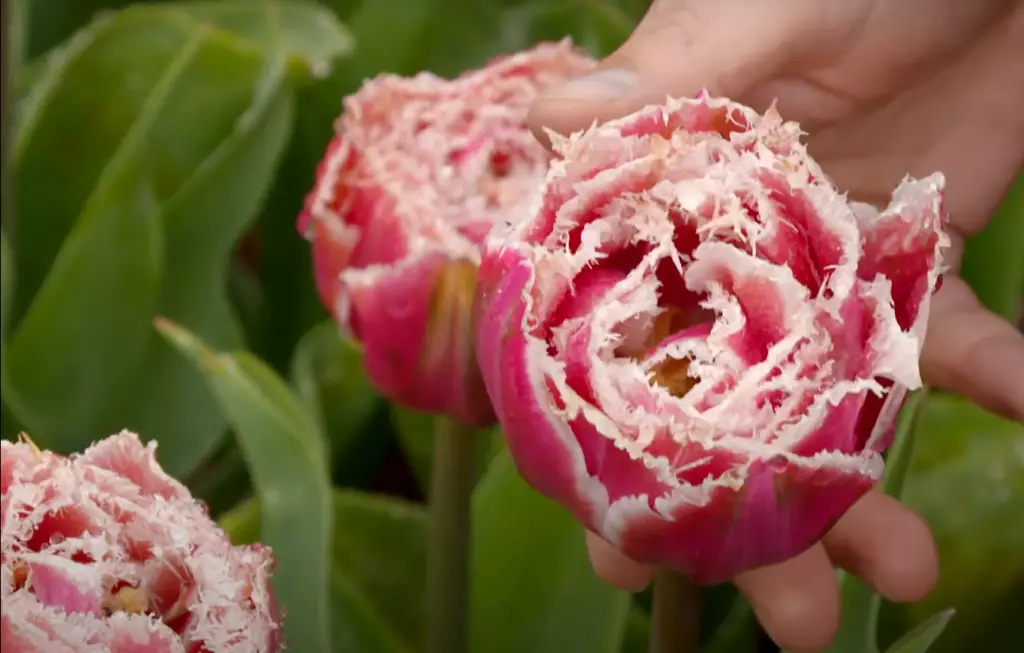
It is also a good idea to provide some shade for your tulips in hot climates as this will protect them from the heat of the day.
Additionally, it’s important to monitor your tulips for signs of pests or disease and take appropriate steps to treat any issues. With a little bit of care, your tulips will be thriving in no time!
Tulip Garden Ideas
Tulips are a classic addition to any garden or landscape. Here are some creative ways to use them:
- Create an eye-catching display by planting tulips of different colors together in clusters or grouped with other types of bulbs like daffodils and hyacinths.
- Plant the tulips along a path or walkway to add a vibrant pop of color.
- Plant shorter varieties of tulips in planter boxes for a lovely way to bring color up from the ground.
- Create an oasis by planting tall tulips along the edge of your garden and filling in with other types of flowers for a beautiful border.
- Plant a combination of tulips and other bulbs for a stunning show of color in the spring.
- Use tulips to create an edible border around vegetable or herb gardens, providing pollen for bees and other pollinators while adding some visual appeal.
- Plant tulips in containers on your patio or balcony for a beautiful display that you can enjoy from your favourite outdoor spot.
FAQ
What is the best tulip layout?
For the most impactful display, plant tulips in clusters or group them together with other types of bulbs. When planting in groups, make sure to give each bulb enough space for optimal growth.
How often should I water my tulips?
Tulips should be watered regularly, especially during dry periods or when the temperatures are especially high. Be sure to check the soil regularly and water when it feels dry about an inch below the surface.
What type of soil do tulips prefer?
Tulips prefer a soil that is rich in nitrogen and phosphorus. If your soil is lacking, you can add some fertilizer or compost to give them a nutrient boost.
How can I prevent diseases and pests in my tulips?
The best way to prevent disease and pest problems is to practice good garden hygiene, such as removing any dead or discolored foliage and avoiding overcrowding.
Additionally, monitoring your garden for signs of trouble and taking appropriate action—such as watering more frequently or treating pests—can help you keep your tulips healthy.
Can I grow tulips in containers?
Yes! Tulips can be grown in containers, either indoors or outdoors, as long as the container is large enough and has adequate drainage. Be sure to use a good quality potting soil and water regularly for the best results.
What is the best month to plant tulip bulbs?
The best time to plant tulips is in the fall, usually between October and December. Planting during this time ensures that your bulbs have enough time to establish strong roots before winter sets in.
Where is the best place to plant tulips in a garden?
Tulips look great planted in clusters, along pathways or borders, or in planter boxes. Choose a place with full sunlight and rich, well-draining soil for optimal results.
How do you lay out tulips?
When laying out tulips, be sure to give each bulb enough space for optimal growth. Additionally, it’s best to plant taller varieties in the back and shorter ones towards the front of your display.
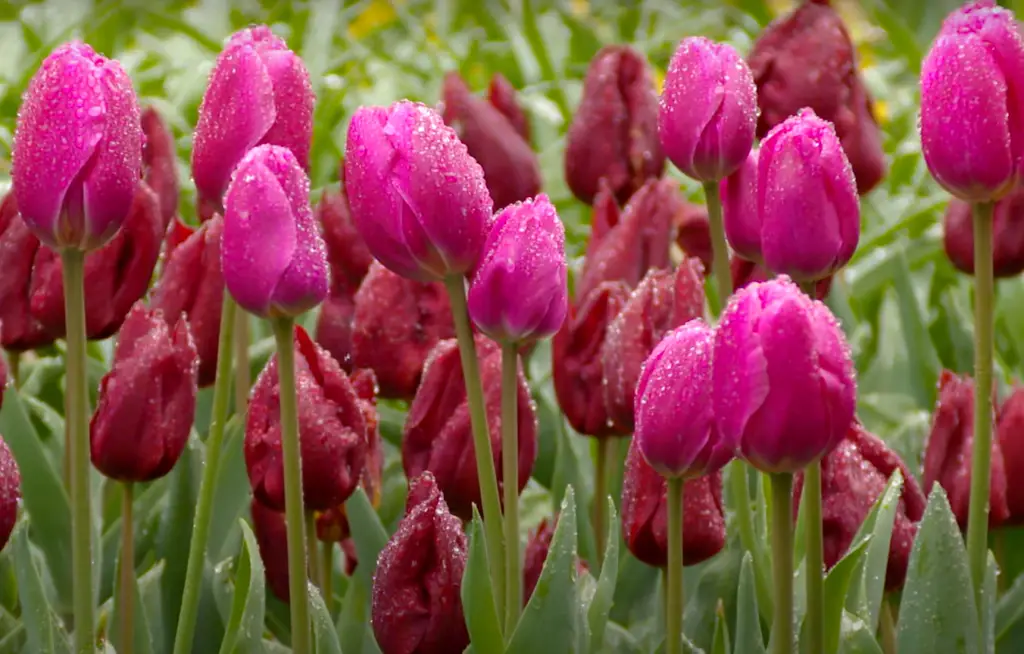
When planting in clusters, try to create a repeating pattern or use colors that complement one another.
Are tulips easy to take care of?
Yes! With the right amount of sunlight, water and soil, tulips are fairly easy to take care of.
Make sure to check your plants regularly for signs of disease or pests and water when the soil feels dry about an inch below the surface. With a little bit of care, your tulips will be thriving in no time!
What else can I do with tulips in my garden?
Tulips are a great addition to any garden and can be used in many different ways. Planting them along pathways or borders adds a splash of color, while planting taller varieties at the back of your display creates a stunning backdrop.
Try combining tulips with other types of bulbs to create a unique and beautiful show of color. You can also use tulips to create an edible border around vegetable or herb gardens, providing pollen for bees and other pollinators while adding some visual appeal.
Can you leave tulip bulbs in the ground all year?
No, it’s best to dig up your tulip bulbs in the late summer and store them in a cool, dry place until it’s time to replant again. This will prevent disease and pests from taking over your tulips during the winter months.
Are there any special care instructions for tulips?
Yes, there are some special care instructions for tulips. Be sure to water them regularly during dry periods or when temperatures are especially high.
Additionally, it’s important to check the soil regularly and watch for signs of disease or pests—such as discolored leaves or wilting plants—and take appropriate action if necessary.
Do tulips multiply?
Yes, tulips can multiply over time. However, this process takes several years and requires dividing the bulbs after they’ve bloomed in the spring. It’s important to note that young divisions may not produce flowers until the following season.
What are the best tips for growing tulips?
The best tips for growing tulips include planting in a sunny location with well-drained soil, watering regularly, and providing adequate space between each bulb.
Additionally, it’s important to practice good garden hygiene such as removing dead foliage or discolored leaves and monitoring your plants for signs of disease or pests.
Are there any other garden ideas with tulips?
Yes! There are many creative garden ideas you can use with tulips. Planting them along pathways or borders adds a splash of color, while combining them with other types of bulbs creates a unique and beautiful show of color.
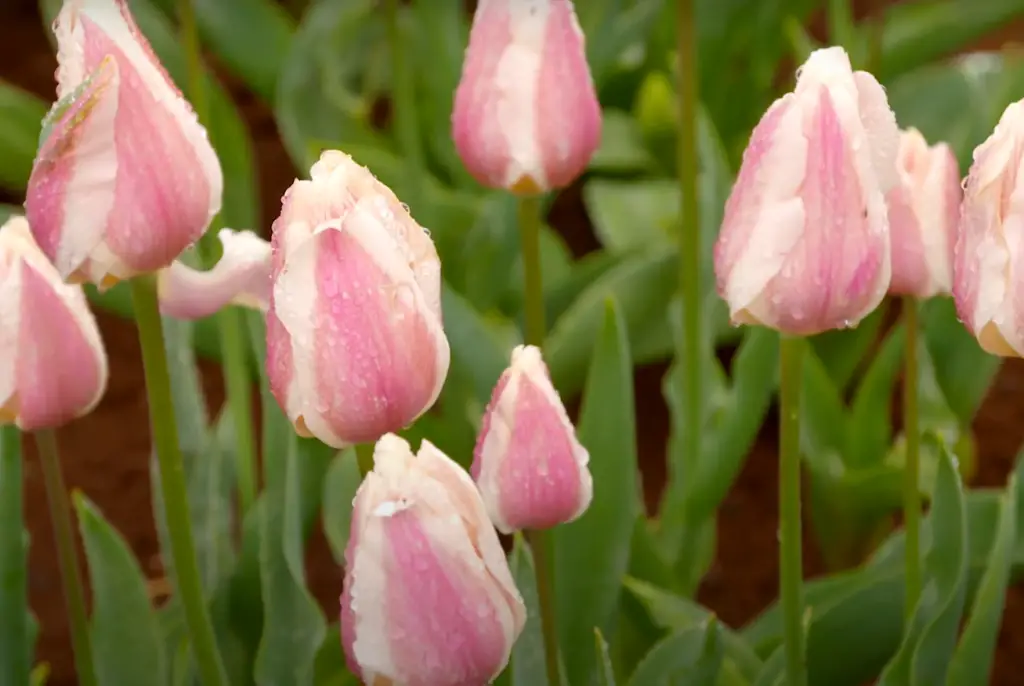
You can also use tulips to create an edible border around vegetable or herb gardens, providing pollen for bees and other pollinators while adding some visual appeal.
Additionally, you can plant them in planter boxes for added charm or hang them from trellises for a whimsical look.
What can I do to keep my tulips looking their best?
To keep your tulips looking their best, it’s important to water regularly and make sure the soil has adequate drainage.
Additionally, practice good garden hygiene such as removing dead foliage or discolored leaves and monitoring your plants for signs of disease or pests. Finally, be sure to fertilise your soil regularly to promote healthy growth and get the most out of your tulips.
What types of tulips work best in different climates?
Tulips come in many varieties, each of which works best in certain climates. For example, early blooming varieties are better suited for cooler regions with shorter growing seasons. Meanwhile, late-blooming varieties thrive better in warmer climates with longer growing seasons.
Additionally, some varieties are more tolerant of wet or dry conditions, or can even withstand extreme temperatures. When choosing the right type of tulip for your garden, it’s important to consider your climate and specific growing conditions.
What is the best way to store tulip bulbs for winter?
The best way to store tulip bulbs for winter is to dig them up in late summer and place them in mesh bags or cardboard boxes. Be sure to place the bulbs in a cool, dry place such as a basement, closet, or storage shed.
Additionally, you may want to add some sand, sawdust, or peat moss for extra insulation. This will help protect your bulbs from disease and pests during the winter months.
How often should I replant tulip bulbs?
Tulips can be replanted every two to three years, depending on the size of your garden. It’s important to remove and discard any bulbs that are beginning to show signs of disease or pests, as well as any dead foliage, before replanting.
Additionally, it’s best to fertilise the soil before planting, as this will provide nutrients necessary for healthy growth.
Finally, be sure to give your tulips plenty of sunlight and adequate space between each bulb. This will help promote strong blooms and ensure that your tulip garden looks its best.
How can I get the most out of my tulip garden?
To get the most out of your tulip garden, it’s important to practice good gardening techniques. Water regularly and make sure the soil has adequate drainage.
Fertilise your soil regularly to promote healthy growth and get the most out of your tulips. Finally, be sure to give your tulips plenty of sunlight and provide adequate space between each bulb for best results.
How can I protect my tulips from animals and insects?
To protect your tulips from animals and insects, it’s important to practice good gardening techniques. Water regularly and make sure the soil has adequate drainage.
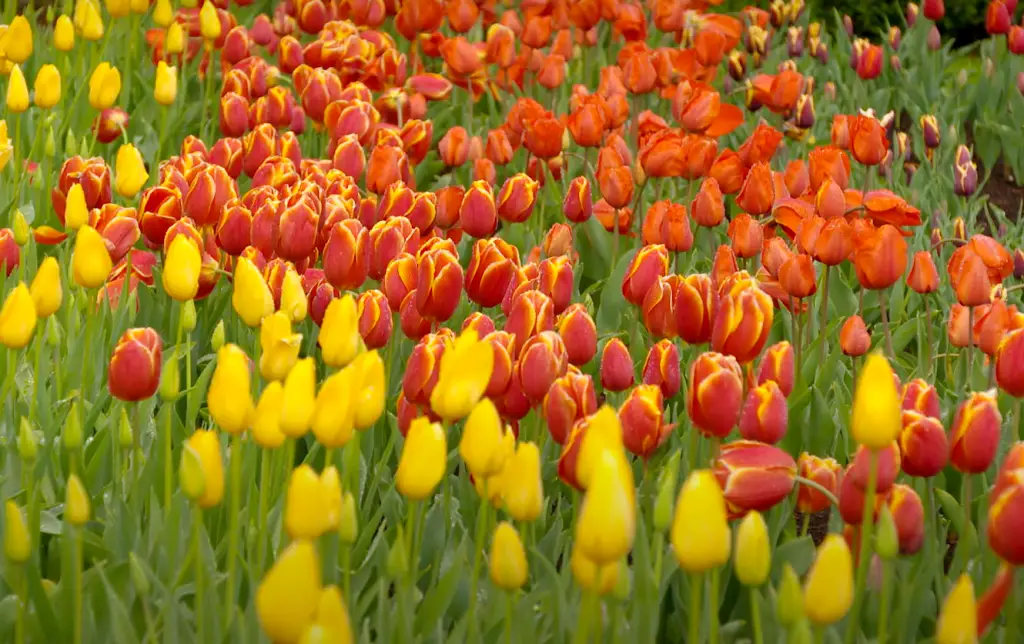
Additionally, remove any dead foliage or discolored leaves as soon as possible to prevent disease or pests from spreading.
You may also want to use insecticides or other pest control measures, particularly if there is a large infestation. Finally, consider using fencing or netting to keep animals away from your tulip garden.
How can I ensure my tulips look their best when in bloom?
To ensure your tulips look their best when in bloom, it’s important to practice good gardening techniques. Water regularly and make sure the soil has adequate drainage.
Additionally, fertilise your soil regularly to promote healthy growth and get the most out of your tulips. Finally, provide adequate space between each bulb and give your tulips plenty of sunlight. This will help promote strong blooms and ensure that your tulip garden looks its best.
Additionally, be sure to remove any dead foliage or discolored leaves as soon as possible to prevent disease or pests from spreading. These measures will help ensure that your tulips look their best when in bloom.
Does deadheading tulips help them to bloom again?
Deadheading, or removing spent blooms, can help tulips to bloom again. Deadheading helps to encourage new growth and prevents the plant from expending energy on producing seeds.
Additionally, it can also help to promote stronger blooms and a fuller display when the tulips do return.
To deadhead tulips, simply remove the spent blooms and discard them. Do not put them in your compost pile as this can spread disease and pests to other plants. Finally, make sure to fertilise regularly and provide adequate sunlight for best results.
Do tulips need to be deadheaded after flowering?
Yes, it is important to deadhead tulips after flowering in order to promote strong blooms the following year. Deadheading helps to encourage new growth and prevents the plant from expending energy on producing seeds.
Additionally, it can also help to promote stronger blooms and a fuller display when the tulips do return. To deadhead tulips, simply remove the spent blooms and discard them. Do not put them in your compost pile as this can spread disease and pests to other plants.
Does mulching help tulips?
Mulching can be beneficial to tulips, as it helps the soil retain moisture and nutrients necessary for healthy growth. Additionally, by keeping weeds down, mulching can also reduce competition for resources and increase your chances of success with your tulip garden
However, make sure to use an organic mulch so that it can eventually break down and add nutrients to the soil. Finally, be sure to water regularly and practice good garden hygiene such as removing dead foliage or discolored leaves for best results.
What type of fertilizer should I use on my tulips?
When fertilising your tulip garden, a slow-release fertilizer with a balanced ratio of nitrogen, phosphorus and potassium (N-P-K) is best. Make sure to apply it evenly throughout the bed and water lightly after application. You may also want to consider using a fertilizer specifically designed for tulips or other flowering bulbs, as these are formulated to meet their specific needs.
Does my tulip garden need to be protected from animals?
Yes, it is important to protect your tulip garden from hungry animals. Consider using fencing or netting around the perimeter of the bed to keep out deer, rabbits and other critters. Additionally, make sure that there are no holes or gaps in the fence for animals to get through.
Does my tulip garden need to be pruned?
Pruning is not necessary for tulips, as they will naturally die back after flowering. However, it is important to remove the dead foliage and discolored leaves to prevent disease or pests from spreading.
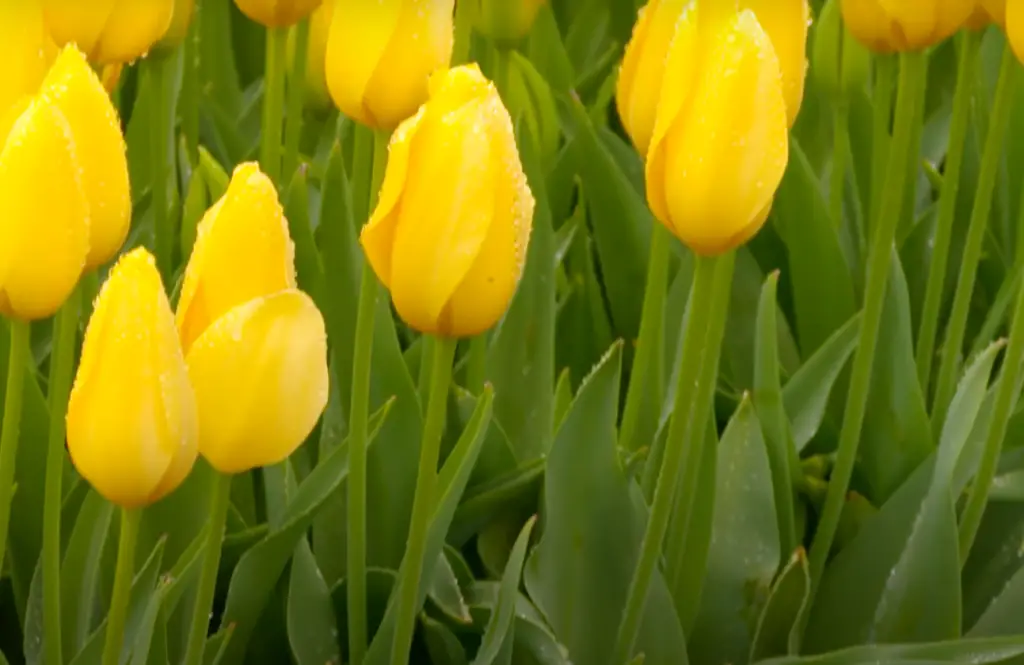
Additionally, you may want to consider removing any competing vegetation that could draw resources away from your tulips. Finally, make sure to fertilise regularly and provide adequate sunlight for best results.
Do tulips need to be divided?
Tulips do not need to be divided, as they are typically self-sufficient. However, if you find that the bulbs are overcrowded or the blooms are becoming smaller and less vibrant, then it is a good idea to divide them.
This will help ensure that your tulip garden looks its best. Simply dig up the bulbs and gently pull them apart, making sure to discard any diseased or damaged bulbs. Replant the divided bulbs in a well-draining soil and make sure to water regularly for best results.
Can I grow tulips indoors?
Yes, it is possible to grow tulips indoors. It is important to make sure that the indoor area is well-lit and has adequate airflow.
Additionally, use a potting soil specifically made for bulbs, as this will help ensure good drainage. Finally, water regularly and provide fertilizer at least once per month for best results.
Can I grow tulips in containers?
Yes, it is possible to grow tulips in containers. Make sure to use a potting soil specifically made for bulbs and that the container has adequate drainage holes. Additionally, consider using a self-watering system or other irrigation device to ensure that your plants are getting enough water. Finally, be sure to fertilise regularly for best results.
Which type of tulip should I choose for my garden?
When choosing the right tulips for your garden, consider both their bloom time and the color of their blooms.
Additionally, look for varieties that are disease-resistant and suited to your climate. Finally, check with a local nursery or garden centre to see what options they have available.
Which environment is best for growing tulips?
Tulips prefer full sun and well-drained soil.
Also consider adding a layer of mulch around the plants to protect them from extreme temperatures and insulate their roots. Finally, make sure to water regularly and fertilise as needed for best results.
How often should I water my tulips?
Tulips need to be watered regularly during their growing season, usually once every week or two. However, do not overwater the plants or allow them to sit in standing water, as this can cause root rot and other issues.
Additionally, keep an eye on the soil to make sure it is not too dry or too wet. Finally, consider using a self-watering system or other irrigation device for best results.
Useful Video: Everything you Need to Know About Tulips | GARDEN | Great Home Ideas
Conclusion
Hopefully this blog post gave you plenty of ideas and inspiration to kick-start or reinvigorate your own garden. Tulips are a beautiful flower that can look incredible in any garden, no matter the size. They have an array of vibrant colors, bloom times, shapes and petal counts for you to select from for your own creation.
Additionally, tulips don’t need much tending: they require healthy soil, fertilizer and attention if needed but naturally do very well in most climates. We hope you found success with our advice on how to plan for tulip gardening, and wish you luck in creating the garden space of your dreams!
If you still feel overwhelmed with picking out perennials, annuals and other spring flowers, remember that local experts can help you design your dream without delay.
Finally, if a vacation is more up your alley than hours spent preparing the ground or planting bulbs after digging up dirt – why not treat yourself to a trip through some of the world’s great gardens where these beautiful blooms will show their full potential.
No matter what journey you choose or what route you opt for- there’s nothing quite like seeing nature bloom at its very best. So don’t just dream craft – be sure to get out there and enjoy your garden too!
References:
- https://www.gardendesign.com/bulbs/tulips.html










Leave a Reply
View Comments